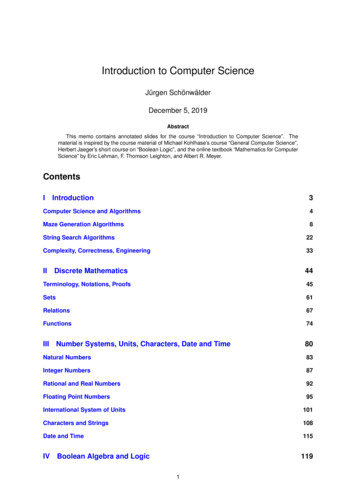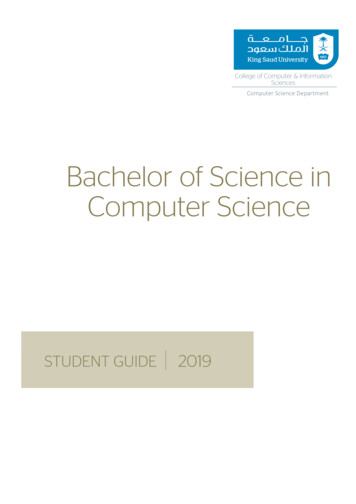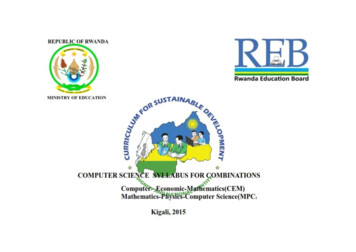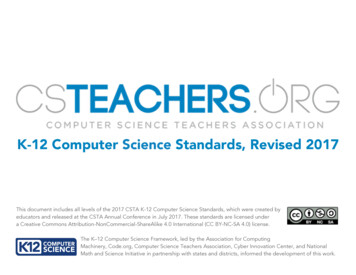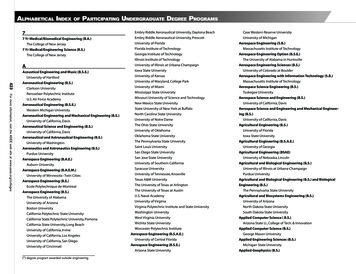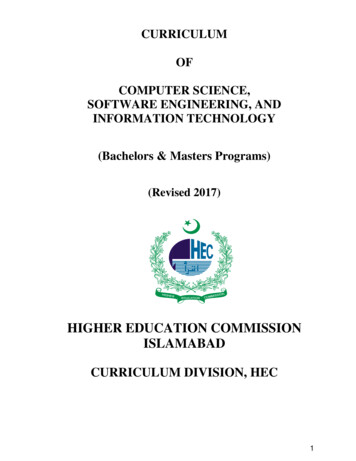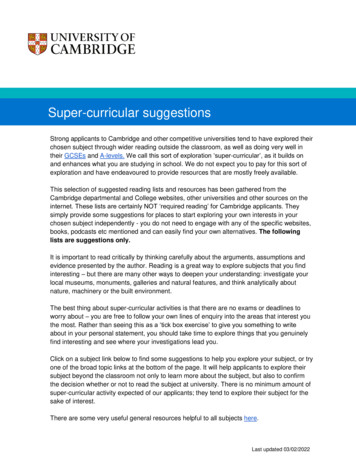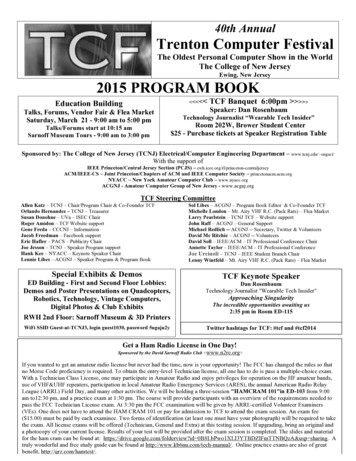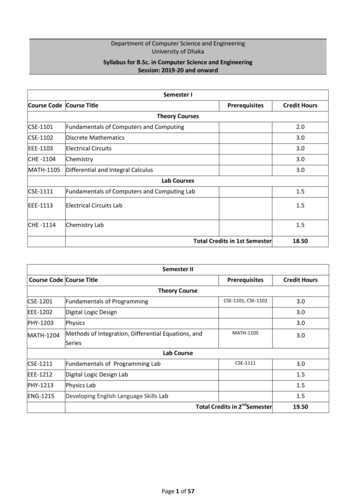
Transcription
Department of Computer Science and EngineeringUniversity of DhakaSyllabus for B.Sc. in Computer Science and EngineeringSession: 2019-20 and onwardSemester ICourse Code Course TitlePrerequisitesCredit HoursTheory CoursesCSE-1101Fundamentals of Computers and Computing2.0CSE-1102Discrete Mathematics3.0EEE-1103Electrical Circuits3.0CHE -1104Chemistry3.0MATH-1105 Differential and Integral Calculus3.0Lab CoursesCSE-1111Fundamentals of Computers and Computing Lab1.5EEE-1113Electrical Circuits Lab1.5CHE -1114Chemistry Lab1.5Total Credits in 1st Semester18.50Semester IICourse Code Course TitlePrerequisitesCredit HoursCSE-1101, CSE-11023.0Theory CourseCSE-1201Fundamentals of ProgrammingEEE-1202Digital Logic Design3.0PHY-1203Physics3.0MATH-1204 Methods of Integration, Differential Equations, andSeriesMATH-11053.0CSE-11113.0Lab CourseCSE-1211Fundamentals of Programming LabEEE-1212Digital Logic Design Lab1.5PHY-1213Physics Lab1.5ENG-1215Developing English Language Skills Lab1.5ndTotal Credits in 2 SemesterPage 1 of 5719.50
Semester IIICourse CodeCourse TitlePrerequisitesCredit HoursTheory CoursesCSE-2101Data Structures and AlgorithmsCSE-12013.0CSE-2102Object Oriented ProgrammingCSE-12013.0EEE-2103Electronic Devices and CircuitsEEE-12023.0GED-2104Bangladesh StudiesMATH-2105Linear Algebra2.0MATH-12043.0Lab CoursesCSE-2111Data Structures and Algorithms LabCSE-12111.5CSE-2112Object Oriented Programming LabCSE-12111.5EEE-2113Electronic Devices and Circuits LabEEE-12120.75Total Credits in 3rd Semester17.75Semester IVCourse CodeSemester IVCourse TitlePrerequisitesCredit HoursTheory CoursesCSE-2201Database Management Systems - ICSE-21013.0CSE-2202Design and Analysis of Algorithms - ICSE-21013.0CSE-2203Data and TelecommunicationCSE-21013.0CSE-2204Computer Architecture and OrganizationEEE-12023.0CSE-2205Introduction to MechatronicsEEE-1103, EEE-12022.0Lab CoursesCSE-2211Database Management Systems - I LabCSE-21111.5CSE-2212Design and Analysis of Algorithms - I LabCSE-21111.5CSE-2213Data and Telecommunication LabCSE-21110.75CSE-2216Application Development LabCSE-2101, CSE-2102,CSE-2111, CSE-21121.5Total Credits in 4th SemesterPage 2 of 5719.25
Semester VCourse CodeCourse TitlePrerequisitesCredit HoursTheory CoursesCSE-3101Computer NetworkingCSE-22033.0CSE-3102Software EngineeringCSE-2101, CSE21023.0CSE-3103Microprocessor and MicrocontrollerCSE-22043.0CSE-3104Database Management Systems - IICSE-22013.0MATH-3105Multivariable Calculus and GeometryMATH-21053.0Lab CoursesCSE-3111Computer Networking LabCSE-22131.5CSE-3112Software Engineering LabCSE-2111, CSE-21120.75CSE-3113Microprocessor and Assembly Language LabCSE-3116Microcontroller Lab1.50.75thTotal Credits in 5 Semester19.50Semester VICourse CodeCourse TitlePrerequisitesCredit HoursTheory CoursesCSE-3201Operating SystemsCSE-2202, CSE-22043.0CSE-3202Numerical MethodsCSE-22023.0CSE-3203Design and Analysis of Algorithms - IICSE-22023.0CSE-3204Formal Language, Automata and ComputabilityCSE-11023.0STAT-3205Introduction to Probability and Statistics3.0Lab CoursesCSE-3211Operating Systems LabCSE-22121.5CSE-3212Numerical Methods LabCSE-22120.75CSE-3216Software Design Patterns LabCSE-31121.5ENG-3217Technical Writing and Presentation LabENG-12150.75thTotal Credits in 6 SemesterPage 3 of 5719.50
Semester VIICourse CodeCourse TitlePrerequisitesCredit ry CourseCSE-4101Artificial IntelligenceCSE-4102Mathematical and Statistical Analysis for EngineersCSE-4XXXAny course from Option - A3.0CSE-4XXXAny course from Option - B3.0Lab CoursesCSE-4111Artificial Intelligence LabCSE-4XXXLab for the Option - A courseCSE-4113Internet Programming tal Credits in 7 Semester18.50Semester VIIICourse CodeCourse TitlePrerequisitesCredit HoursTheory CoursesECO-4201Economics2.0CSE-4202Society and Technology2.0CSE-4XXXAny course from Option - A (excepting the course takenin semester VII)Any course from Option - B (excepting the course takenin semester VII)Lab Courses3.0Lab for the Option - A course (excepting the coursetaken in semester otal Credits in 8th SemesterSummary of Eight Semesters1st Semester (1st Year 1st Semester)2nd Semester (1st Year 2nd Semester)3rd Semester (2nd Year 1st Semester)4th Semester (2nd Year 2nd Semester)5th Semester (3rd Year 1st Semester)6th Semester (3rd Year 2nd Semester)7th Semester (4th Year 1st Semester)8th Semester (4th Year 2nd Semester)Total Credits in Eight Semesters:Page 4 of 015.50
Option - ACourse Code Course TitleCredit HoursTheory CoursesCSE-4121Robotics Science and Systems3.0CSE-4123Computational Methods in Bio-molecular Sequence & Structure Analysis3.0CSE-4125Introduction to Machine Learning3.0CSE-4127Information Retrieval3.0CSE-4131Introduction to VLSI Design3.0CSE-4133Algorithm Engineering3.0CSE-4135Software Requirements Specification and Analysis3.0CSE-4137Cryptography and Security3.0CSE-4139Computer Graphics3.0CSE-4221Robot Learning3.0CSE-4223Fundamentals of Genomics and Proteomics3.0CSE-4225Introduction to Data Mining and Warehousing3.0CSE-4227Cloud Computing3.0CSE-4229Introduction to Reversible Computing3.0CSE-4231Computational Geometry3.0CSE-4233Software Testing and Verification3.0CSE-4235Digital Forensic3.0CSE-4237Digital Image Processing3.0CSE-4239Parallel and Distributed Systems3.0Corresponding Lab Courses for Option-ACSE-4151Robotics Science and Systems Lab1.5CSE-4153Computational Methods in Bio-molecular Sequence & Structure Analysis Lab1.5CSE-4155Introduction to Machine Learning Lab1.5CSE-4157Information Retrieval Lab1.5CSE-4161Introduction to VLSI Design Lab1.5CSE-4163Algorithm Engineering Lab1.5CSE-4165Software Requirements Specification and Analysis Lab1.5CSE-4167Cryptography and Security Lab1.5CSE-4169Computer Graphics Lab1.5CSE-4251Robot Learning Lab1.5CSE-4253Fundamentals of Genomics and Proteomics Lab1.5CSE-4255Introduction to Data Mining and Warehousing Lab1.5CSE-4257Cloud Computing Lab1.5CSE-4259Introduction to Reversible Computing Lab1.5CSE-4261Computational Geometry Lab1.5Page 5 of 57
CSE-4263Software Testing and Verification Lab1.5CSE-4265Digital Forensic Lab1.5CSE-4267Digital Image Processing Lab1.5CSE-4269Parallel and Distributed Systems Lab1.5Option - BCourse Code Course TitleCredit HoursTheory CoursesCSE-4122Mathematics for Robotics3.0CSE-4124Introduction to Bioinformatics3.0CSE-4126Introduction to Data Science3.0CSE-4128Wireless Networks3.0CSE-4130Introduction to Quantum Logic3.0CSE-4132Graph Theory3.0CSE-4134Software Project Management3.0CSE-4136Computer Security3.0CSE-4140Compiler Design3.0CSE-4222Human Robot Interaction3.0CSE-4224Mobile Robotics3.0CSE-4226Aerial Robotics3.0CSE-4228Application of Computational Biology3.0CSE-4230Human Computer Interaction3.0CSE-4232Internet of Things3.0CSE-4234Introduction to Multiple-Valued Logic3.0CSE-4236VLSI Layout Algorithms3.0CSE-4238Concepts of Concurrent Computation3.0CSE-4240Applied Cryptography3.0CSE-4242Computer Vision3.0CSE-4244Computer and Network Security3.0CSE-4246Natural Language Processing3.0Page 6 of 57
Semester I (1st year 1st Semester)CSE-1101: Fundamentals of Computers and Computing [2.0 credits, 30hours lecture](Pre-requisite Courses: None)Introduction to Computers: From a Key Press to Display, Hardware,Software, Operating System, Microprocessor, Memory Overview, Fileand File System. Input-Output Devices. Application Software: BasicText Editor (gedit, Notepad), Document Processing, Spreadsheet,Presentation, Database, Mathematical Analysis, Simulation, Imageand Video Editing, Games etc.Network and Internet:NetworkingConcept and Topologies, Network Addresses (MAC, IP and Port), Namevs. IP (role of DNS).Browser Software: Examples, URL, Security,Email, Email Address, Email - Client Software, Email Software inthe Internet, Network Configuration and Basic Tools (ping,traceroute etc.). Number System:Concept of Bit, ElectronicRepresentation of Bits.Bit- Array: Byte, Word, Double Word. Binary– to- Decimal Conversion, Binary Arithmetic, Bit- Shifting, LogicRepresentation (1-Bit, Bit- Array). Hexadecimal Arithmetic up ,Hexadecimal and Octal Numbers. Representation of Characters byBit- Array: ASCII and UTF-8. Character Arithmetic: Case andLanguage Mapping and Changing.Memory: Introduction to nditionalStatements (Nested If).CSE-1102: Discrete Mathematics [3.0 credits, 45 hours lecture](Pre-requisite Courses: nsofPropositional Logic, Propositional Equivalences, Predicates andQuantifiers, Nested Quantifiers, Rules of Inference, Introductionto Proofs. Set, Function, Sequence, Summation and Matrix: Sets,Set Operations, Functions, Sequences and Summations, Zero – OneMatrices, Boolean Product.Number Theory: Divisibility and ModularArithmetic, Integer Representations and Algorithms, Primes andGreatest Common Divisors, Modular Exponentiation. Induction:Mathematical Induction. Counting: The Basics of Counting, thePigeonhole Principle, Permutations and Combinations, tationsandCombinations.Recursion: Applications of Recurrence Relations.Page 7 of 57
Inclusion Exclusion: Inclusion – Exclusion. Relations: Relationsand Their Properties, Representing Relations. Graphs: Graphs andGraph Models, Graph Terminology and Special Types of Graph, Eulerand Hamilton Paths. Trees: Introduction to Trees.EEE-1103: Electrical Circuits [3.0 credits, 45 hours lecture](Pre-requisite Courses: None)Resistor: Properties, Types of Resistors, Ohm’s Law, Power, Energy,Efficiency, etc. Series DC Circuits: Kirchhoff’s Voltage Law,Voltage Divider Rule, Power Distribution, Voltage Regulation,Voltage Sources in Series, etc. Parallel DC Circuits: Conductanceand Resistance, Kirchhoff’s Current Law, Current Divider Rule, OpenCircuit, Short Circuit, Voltage Sources in Parallel, etc. DC Series- Parallel Network: Reduce and Return Approach, Block DiagramApproach, Ladder Networks. Methods of Analysis for DC Networks:Current Source, Source Conversion, Current Sources in Series andParallel, Branch- Current Analysis, Mesh Analysis, Nodal Analysis,Bridge Network and Y- and -Y Conversions. Network Theorems (DC):Superposition, Thevenin’s, Norton’s, Maximum Power Transfer,Millman’s, Substitution, Reciprocity, etc. Capacitor: ElectricField, Capacitance, Dielectric Strength, Leakage Current, Types ofCapacitors, Charging and Discharging Phase, Energy Stored by aCapacitor, Capacitors in Series and Parallel. Inductor: MagneticField, Inductance, Types of Inductors, Faraday’s Law and Lenz’sLaw, Inductors in Series and Parallel. R-L, R-C and R-L-C Circuitswith DC Input. Introduction to Sinusoidal Alternating Waveforms:Definitions, General Format for the Sinusoidal Voltage or Current,Phase Relations, Average and RMS Values etc. Ordinary and FrequencyResponse of Basic R, L and C Elements, Average Power and PowerFactor, Rectangular and Polar Form, Phasors.CHE-1104: Chemistry [3.0 credits, 45 hours lecture] (Pre-requisiteCourses: None)Atomic Structure: Bohr Atomic Model, Limitations of Bohr’s Model,Atomic Spectra, Wave Nature of Electron, Heisenberg mbers,Pauli’sExclusion Principle, Aufbau Principle, Hund’s Rule, ElectronicConfiguration. Periodic Table: s, p, d and f- Block tionship,Metals, Metalloids, Nonmetals and Their Properties, Properties andUses of Noble Gases. Chemical Bonding: Reason of Chemical Bonding,Ionic Bond, Covalent Bond, Coordinate Covalent Bond, HydrogenBond, Metallic Bond, Vander Waal’s Force. Oxidation Reduction:Charge Concept, Electronic Concept, Oxidizing Agent, ReducingAgent, Oxidation Number, Balancing the Oxidation ReductionPage 8 of 57
Equation. Acid Base: Bronsted Concept, Lewis Concept, sandTheirSelection, Buffer, Henderson Equation. State of Matter: Gas Laws:Boyle’s Law, Charles’ Law, Avogadro’s Law, Ideal Gas, Real Gas,Ideal Gas Equation and Its Limitation, Vander Waal’s Equation,Kinetic Theory of Gases. Phase Rule: Definitions, Phase Rule ofWater and Carbon Dioxide. Thermodynamics: First Law, Work Done forExpansion of Gases, Thermochemistry, Second Law, Carnot on,Molecularity and Order of a Reaction, Derivation of Rate –Expression and Half- Life for First Order and Second OrderReactions, Pseudo First Order Reaction. Chemical Equilibrium:Dynamic Behavior of Chemical Equilibrium, Law of Mass Action,Equilibrium Constant, Le Chatelier Principle and Its eProperties.Electrochemistry: Electrolysis, Electrolytes,Electrolytic Potential,Standard Electrode and Standard Electrode Potential, hydrates,Proteins, Nucleic Acid, Polymers and Polymerization Processes.MATH-1105: Differential and Integral Calculus [3.0 credits, 45hours lecture] (Pre-requisite Courses: None)Functions: Graphing Functions, Mathematical Models and Commonlyused Functions (Linear, Polynomial, Power), Mathematical tric,Exponential, and Logarithmic Functions), Transformations s,GrowthofFunctions. Limits:Concepts, One Sided Limits, Infinite limits,Limit Laws, Sandwich Theorem, Formal Definition of Limits andContinuity of Functions, Intermediate Value Theorem and ItsApplication, Limits at Infinity and the Horizontal Asymptotes.Derivatives:Derivatives and Rate of Change, Derivatives asFunctions, Differentiability of Functions, Rules and Techniques ofDifferentiation. Applications of Differentiation:Rates of Changein Natural and Social Sciences, Exponential Growth and Decay,Linear Approximation and Differentials, Finding Minimum andMaximum Value of Functions and the first and Second DerivativeTests, Indeterminate Forms and L'Hospital's Rule, Curve Sketching.Integrals:Riemann Sum and Definite Integrals, Properties ofIntegrals, Fundamental Theorem of Calculus,Anti-Derivative andIndefinite Integral, Net Change Theorem, Substitution Rule.Page 9 of 57
Application of Integration:Finding Area between Curves, Volumes,Volumes by Cylindrical Shells, Average Value of a Function,MeanValue Theorem for Integrals.CSE-1111: Fundamentals of Computers and Computing Lab [1.5Credits, 45 Hours Lab] (Pre-requisite Courses: None)Contents related to the coursework CSE-1101 (Fundamentals of Computersand Computing).EEE-1113: Electrical Circuits Lab [1.5 Credits, 45 Hours Lab](Pre-requisite Courses: None)Contents related to the coursework EEE-1103 (Fundamentals of Electricalsand Electronics).CHE-1114: Chemistry Lab [1.5 Credits, 45 Hours Lab] (Pre-requisiteCourses: None)Contents related to the coursework CHE-1104 (Chemistry).Page 10 of 57
Semester II (1st Year 2nd Semester)CSE-1201: Fundamentals of Programming[3.0 credits, 45 hourslecture] (Pre-requisite Courses: CSE-1101, CSE-1102)Review of Basics: Basic I/O, Data Type, Conditional Logic, SwitchCase, Character, ASCII Value, Reading and Writing rithmetic,Relational, Logical and Bitwise Operators, Operator Precedence ortCutOperator. Functions–I:Basic Functions, Void Functions with NoParameters. Loops: Looping Basic, Necessity of Loops, While Loop,Loop Condition, Body, Initialization, Increment, For Loops, Part ofFor Loops, Do While Loop, Entry Controlled Loops, Exit ControlledLoops, Example, Formulating Problems Using Loops. FormattedI/O:Specifying Width using Format Specifier in printf and scanf inDetails. Nested Loop: Nesting of Two Loops, Example, Nesting ofIndependent Loops inside One, Example, Nesting of More Than TwoLoops. Functions – II: Functions with Return Type and TrivialParameters, Local and Global Variables, Call by Value, fArray,Necessity, Declaration, Accessing through Indices, Accessing rays,Declaration, Initialization, Accessing through Loops, Example,Multidimensional Arrays, Example. Functions – III: Passing Arraysin a Function as Parameter, Call by Reference, Recursion, ScopeVisibility and Lifetime of Variable. Strings: Basics, Differencebetween String and Character Array, I/O, Basic Operations withoutusing Library Functions, Array of Strings. String Library: ubstring,Reverse. Structures:Basics, Necessity, Declaration, Accessing,Initialization, Array of structures. Pointers: Basics, Uses,Pointer Operation, Call by Reference using Pointers, Pointer for1D/2D/3D Array, Structure, Pointer Expression, Array of Pointers,Function Returning Pointers. Dynamic Memory Allocation: Basics,Uses, Malloc, Free, Calloc, Realloc. File Operation: Basics, Uses,File Opening, Closing, File I/O, Use of Redirect Operator to Writein File or Read from File. Preprocessors and Macros.Page 11 of 57
EEE-1202: Digital Logic Design [3.0 credits, 45 hours lecture](Pre-requisite Courses: None)Introduction: Introductory Concepts, Binary, Octal and HexadecimalNumber System BCD, ASCH and EBCDIC Codes, Combinatorial Logic:Data Representation Logic Gates and Boolean Algebra, CombinationalCircuits Design using NAND of NOR Gates Only. Introduction toDecision Diagram, Minimization of Switching Functions AlgebraicSimplification, Karnaugh Map, VEKM, Quince McCluskey Method.Sequential Logic: NAND and NOR Latches. Clocked SR. JK D and TFlip - Flops. FF Timing Consideration. Master- Slave FF. ComplexSequential logic: Frequency Division and Counting TroubleshootingCase Studies. Asynchronous Ripple Up and Down Counters, Counterswith Any MOD Numbers Asynchronous IC Counters, Propagation Delay.Parallel Up Down and Up/Down Counters. Presentable Counters. The74193 Counter. Decoding a Counter. Cascading Counters. ShiftRegisters, IC Shift Digital Clock. MSI Logic Circuits: BCD – to Decimal Decoders, BCD – to- 7 Segment Decoder/Drivers. Encoders.Multiplexer and Demultiplexer. Integrated Circuits Logic Families:TTL Logic Family Standard TTL Series Characteristics, Other TTLSeries TTL Loading Rules, Digital MOSFET Circuits. Memory Devices:Semiconductor Memory Technologies ROM Architecture Timing and Typeof ROM, EPROM, EEPROM, ROM Applications. RAM Architecture Staticand Dynamic RAM, DRAM Structure Operation and Refreshing.Introduction to Sequential Circuits, Formal Representation ofSequential Circuits. Arithmetic circuits: The Half- Adder FullAdder. Parallel Adders.PHY-1203: Physics [3.0 credits, 45 hours lecture](Pre-requisite Courses: None)Heat and Thermodynamics: Introductory Concepts and Zeroth Law,Energy Considerations, Work and Heat, Units, ThermodynamicProcess, Properties and Equilibrium, First Law of Thermodynamicsand It’s Applications, Reversible and Irreversible Processes,Second Law of Thermodynamics, Carnot Cycle, Efficiency of HeatEngines and Heat Pump, Carnot’s Theorem, Absolute Scale ofTemperature, Entropy. Structure of Matter: Crystalline & NonCrystalline Solids, Single Crystal and Polycrystal Solids, UnitCell, Crystal Systems, Co-ordinations Number, Crystal Planes andDirections, Packing Factor, Miller Indices, Bragg’s Law, Defectsin Solids, Point Defects, Line Defects, Bonds in Solids,Interatomic Distances, Introduction to Band Theory, HarmonicOscillator, Total Energy and Average Energy, Combination of SimpleHarmonic Oscillations, Issajous’ Figures, Spring- Mass System,Damped Oscillation, Forced Oscillation, Resonance, Two- BodyPage 12 of 57
Oscillations, Reduced Mass, Differential Equation of a ProgressiveWave, Power and Intensity of Wave Motion, Stationary Wave, cs,Reverberation and Sabine’s Formula. Physical Optics: Theories ofLight, Interference of Light, Young’s Double Slit Experiment,Displacements of Fringes and Its Uses, Fresnel Bi- Prism, ,FresnelandFraunhoffer Diffraction, Resolving Power of Optical Instruments,Diffraction at Double Slit & N – Slits, Diffraction Grating,Polarization, Production and Analysis of Polarized Light.MATH-1204: Methods of Integration, Differential Equations andSeries [3.0 credits, 45 hours lecture] (Pre-requisite Courses:MATH-1105)Techniques of Integration: Integration by Parts, TrigonometricSubstitution, Partial Fractions, Computer Algebra Systems (e.g.,Mathematica, Sage), Approximate Integration - Simpson's Rule,Improper Integrals. Application of Integration: Arc Length, Areaof a Surface of Revolution. Differential Equations: Modeling ntialEquations, Direction Fields and Euler's Method, Methods forSeparable Equations and Linear Equations. Parametric Equations andPolar Coordinates: Curves Defined by Parametric Equations,Calculus with Parametric Curves, Polar Coordinates, Area andLength in Polar Coordinates, Conic Sections in Polar Coordinates.Sequence and Infinite Series: Sequence and Convergence ofSequences, Infinite Series and Its Convergence, Convergence Tests,Alternating Series, Power Series and Its Convergence, rinSeries,Applications of Taylor Polynomials, Approximating Functions byPolynomials.CSE-1211: Fundamentals of Programming Lab [3.0 Credits, 90 HoursLab] (Pre-requisite Courses: rkPage 13 of 57CSE-1201(Fundamentalsof
EEE-1212: Digital Logic Design Lab [1.5 Credits, 45 Hours Lab](Pre-requisite Courses: None)Contents related to the coursework EEE-1202 (Digital Logic Design).PHY-1213: Physics Lab [1.5 Credits, 45 Hours Lab] (Pre-requisiteCourses: None)Contents related to the coursework PHY-1203 (Physics).ENG-1215: Developing English Language Skills lab [1.5 Credits, 45Hours Lab] (Pre-requisite Courses: None)Contents are based on Listening, Speaking, Reading and Writing tutorialsto develop English language skills.Page 14 of 57
Semester III (2nd Year 1st Semester)CSE-2101: Data Structures and Algorithms [3.0 credits, 45 hourslecture] (Pre-requisite Courses: CSE-1201)Introduction: Introduction to Data Structures, idea of abstractdata type, preliminary idea of algorithm runtime complexity (BigOh notation), preliminary idea of data structure space complexity.LinkedList: Singly/doubly/circular linked lists, basic operationson linked list (insertion, deletion and traverse), dynamic arrayand its application. Stack and Queue: Basic stack operations(push/pop/peek), stack-class implementation using Array and linkedlist, in-fix to post-fix expressions conversion and e,queue-classimplementation using array and linked list, application- Josephousproblem, palindrome checker using stack and queue. Recursion:Basic idea of recursion (3 laws-base case, call itself, movetowards base case by state change), tracing output of a recursivefunction, applications- merge sort, permutation, combination.Sorting: Insertion sort, selection sort, bubble sort, merge sort,quick sort (randomized quick sort), distribution sort (countingsort, radix sort, bucket sort), lower bounds for sorting, externalsort. Binary Tree: Binary tree representation using array andpointers, traversal of Binary Tree (in-order, pre-order and postorder). Binary Search Tree: BST representation, basic operationson BST (creation, insertion, deletion, querying and traversing),application- searching, sets. Searching: Linear search, binarySearch, application of Binary Search- finding element in a sortedarray, finding nth root of a real number, solving equations. Heap:Min-heap, max-heap, Fibonacci-heap, applications-priority queue,heap sort. General Tree: Implementation, application of generaltree- file system.Disjoint Set: Union find, path compression.Huffman Coding: Implementation, application- Compression. Graph:Graph representation (adjacency matrix/adjacency list), basicoperations on graph (node/edge insertion and deletion), traversinga graph: breadth-first search (BFS), depth-first search (DFS),graph-bicoloring. Self-balancing Binary Search Tree: AVL tree(rotation, insertion). Set Operations: Set representation usingbitmask, set/clear bit, querying the status of a bit, toggling bitvalues, LSB, application of set operations. String ADT: ThePage 15 of 57
concatenation of two strings, the extraction ofsearching a string for a matching substring, parsing.substrings,CSE-2102: Object Oriented Programming [3.0 credits, 45 hourslecture] (Pre-requisite Courses: rview.ObjectOriented Concepts: Modeling problems using object orientedconcepts. Introduction to UML. Encapsulation, Inheritance andPolymorphism. Object Oriented vs. Procedural programming, Basicsof Object Oriented Programming language. Objects and Classes:Attributes and functions, constructors and destructors, l,specialconsiderations in different languages. I/O: Stream and files.Inheritance: Inheriting classes, subclass, super class, accesscontrol, inheritance hierarchy, overriding, dynamic binding,abstract class, inner classes, special considerations in xceptionandexception handling: Exception handling fundamentals, exceptiontypes, chained exception, creating own exception subclasses.Generics or Templates: Special considerations in andimplementingpackage/namespace. Object-oriented Design Principles and examples:Introduction to object-oriented design principles and examples,introduction to object-oriented design. Case Study using ObjectOriented Programming.EEE-2103: Electronic Devices and Circuits [3.0 credits, 45 hourslecture] (Pre-requisite Courses: EEE-1202)Introduction to Semiconductors: Properties, bonds and types ofsemiconductors. Semiconductor Diodes and Special Purpose -Icharacteristics, Basic constructions, characteristics, operationsand uses of special diodes: Light-emitting diode (LED), Zenerdiode etc. Diode Application: Half-wave and full-wave rectifiers –operation and efficiency, Ripple factor, Filter circuits –capacitor input filter, LC filter and Π-filter, Clipping andClamping circuits, Voltage regulation and regulator circuits Zener diode and transistor voltage regulator. Bipolar JunctionTransistors: npn and pnp transistors, amplifying and switchingactions of transistor, transistor characteristics in CB, CE & CCconfigurations, transistor load line and Operating point. BJTBiasing: Faithful amplification, inherent variation of transistorparameters and thermal runway, stabilization and stability factor,methods of BJT biasing, analysis and design of biasing circuits.Single Stage Transistor Amplifier: Single stage amplifier circuit,Page 16 of 57
phase reversal, dc and ac equivalent circuits, load line analysis,voltage gain and power gain, classification of Transistors:Classification of FET, construction, operation and characteristicsof JFET and MOSFET, transfer characteristics and Shockley’sequation, DC biasing of JFET. Power Electronics: ialelectronicsdevices: SCR (Silicon Controlled Rectifier), TRIAC, DIAC etc.Feedback Techniques and Op-amps: Concepts- negative and positivefeedback, characteristics and gain with negative voltage tors.Introduction to IC fabrication.GED-2104: Bangladesh Studies [2.0 credits, 30 hours lecture] (Prerequisite Courses: None)Introduction to the course and its objectives. History and Societyof Bengal under the British rule and Pakistan rule: The impact ofBritish and Pakistan rules on the economy and education of thepeople. Language Movement of 1952, Events Leading to the MassUpsurge of 1969, War of Independence and the Emergence ofBangladesh in 1971. Study of Geography and Resources ofBangladesh: Location, Area, Boundary, Ecological Settings, RiverSystem, Climate, People and Resources of Bangladesh. nguage,Literature, Art and Culture of Bangladesh. Politics, Formation androle of major political parties in Bangladesh and Constitutionaldevelopment of Bangladesh. Economy of Bangladesh. Achievements indifferent sectors (economy, culture, sports etc.) of Bangladesh.Socio-cultural problems and prospects of Bangladesh.Page 17 of 57
MATH-2105: Linear Algebra [3.0 credits, 45 hours lecture] (Prerequisite Courses: MATH-1204)Basics: Matrices, Linear Equations and Gaussian Elimination,Inverse Matrices, LU Factorization. Vector Spaces: Solving systemof linear equations and row space, column space, null space, andRank. Linear independence: basis and dimension. Orthogonalvectors: Subspaces, inner products, projection onto subspaces,projection matrices and least squares, orthogonal basis and GramSchmidt orthogonalization. Determinants and their properties, Cofactors, Cramer's rule and other applications of licationindiagonalization, computing powers of matrice
CSE-3102 Software Engineering CSE-2101, CSE2102 3.0 CSE-3103 Microprocessor and Microcontroller CSE-2204 3.0 CSE-3104 Database Management Systems - II CSE-2201 3.0 MATH-3105 Multivariable Calculus and Geometry MATH-2105 3.0 Lab Courses CSE-3111 Computer Networking Lab CSE-2213 1.5 CSE-3112 Software Engineering Lab CSE-2111, CSE-2112 0.75


